This post may contain affiliate links. Please read our disclosure policy.
Stir fried choy sum is a quick and easy 5-ingredient veggie side that’s full of garlicky flavor and tender-crisp texture.
This recipe walks you through exactly how to get crisp stems, tender leaves, and bold garlic flavor—without ending up mushy or bland. Follow my simple tips to get fresh, vibrant greens every time! And if you love this, don’t miss my Yu Choy with Garlic Sauce—another easy favorite packed with flavor.
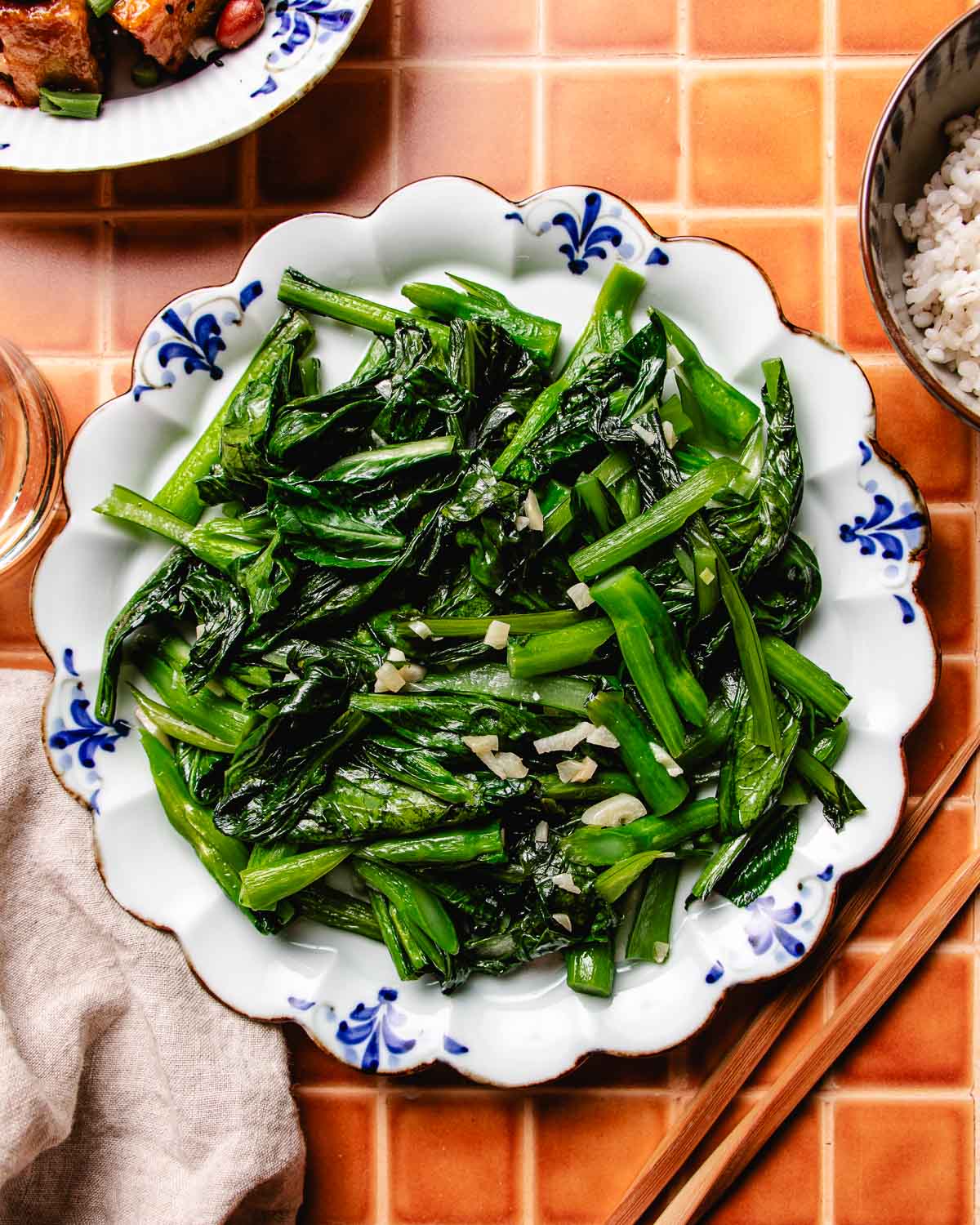
Table of Contents
Main Ingredient Notes
Let’s break down the simple ingredients that make this dish work—and how to get the best results without the guesswork.
Selecting yu choy sum
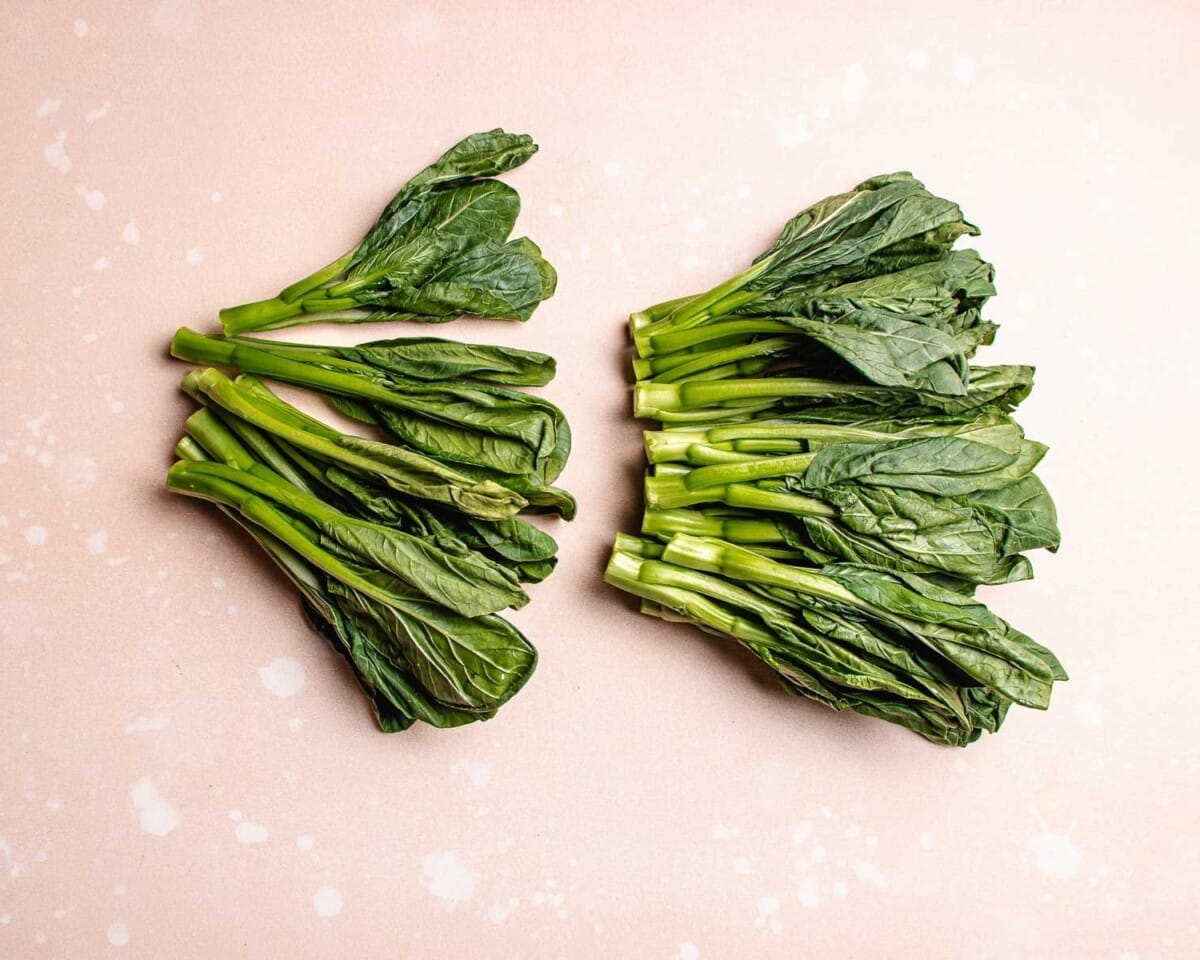
Save This Recipe
Look for yu choy sum with bright green leaves and firm, snappy stems. The leaves should look fresh—not wilted or yellow—and the stems should feel crisp, not floppy or brittle. Closed flower buds are okay, but skip any bunches with blooming flowers or slimy spots.
Stick with the smaller, shorter stalks—about 6.5 to 7 inches (16.5 to 18 cm) long. They’re more tender and cook more evenly. If you’re using larger ones, dice the stems into smaller rounds and cut the leaves into bigger sections. This helps everything cook at the same rate and keeps the texture just right.
Neutral flavored oil
Use a neutral oil like avocado or light olive oil so the garlic and greens shine through. Too much oil can make the dish greasy, while too little makes it dry and flat.
A good rule of thumb: : 👉 about 1 tablespoon (15 ml) of oil per 10 ounces (283 gram) of vegetables. This gives you just enough to coat the greens and bring everything together without weighing it down.
Seasonings
Garlic, coarse sea salt, and a splash of Chinese cooking wine are all you need to bring out the best in the yu choy stir fry. The garlic adds a bold base flavor, the salt highlights the natural sweetness of the greens, and the wine gives the whole dish depth and aroma. It also helps loosen any bits stuck to the pan and softens any sharp or bitter notes in the greens.
For gluten or alcohol-free, use gluten-free sake.
Choy Sum Substitute
If you can’t find yu choy, here are my top picks in order of texture and flavor:
- Tatsoi – Tender with a mild, slightly mustardy flavor. Closest match in texture and cooks super fast.
- Little bok choy or baby bok choy – Crunchier stems and milder taste, but still a great option for stir-fries.
- Chinese broccoli (gai lan) – Thicker stems and a more pronounced flavor. Slightly more bitter, but holds up well in a hot wok. Dice up the stems so they cook faster and blend better with the leafy parts.
How to stir fry choy sum (without it turning mushy)
Getting that perfect stir fried choy sum—crisp stems, tender leaves, and bold garlic flavor—comes down to a few small but important steps. Here’s how each part of the cooking process helps you avoid the most common problems and gives you that vibrant, flavorful result.
- Start with Clean, Crisp Greens

Yu cai can hide a lot of dirt between the stalks and leaves. Soaking it in a big bowl of cold water, and gently separating the layers, helps you clean it thoroughly without bruising the greens. Trimming off the dry ends gives a cleaner bite and helps the stems cook evenly—no tough bottoms here.
- Why Separate the Stems from the Leaves?
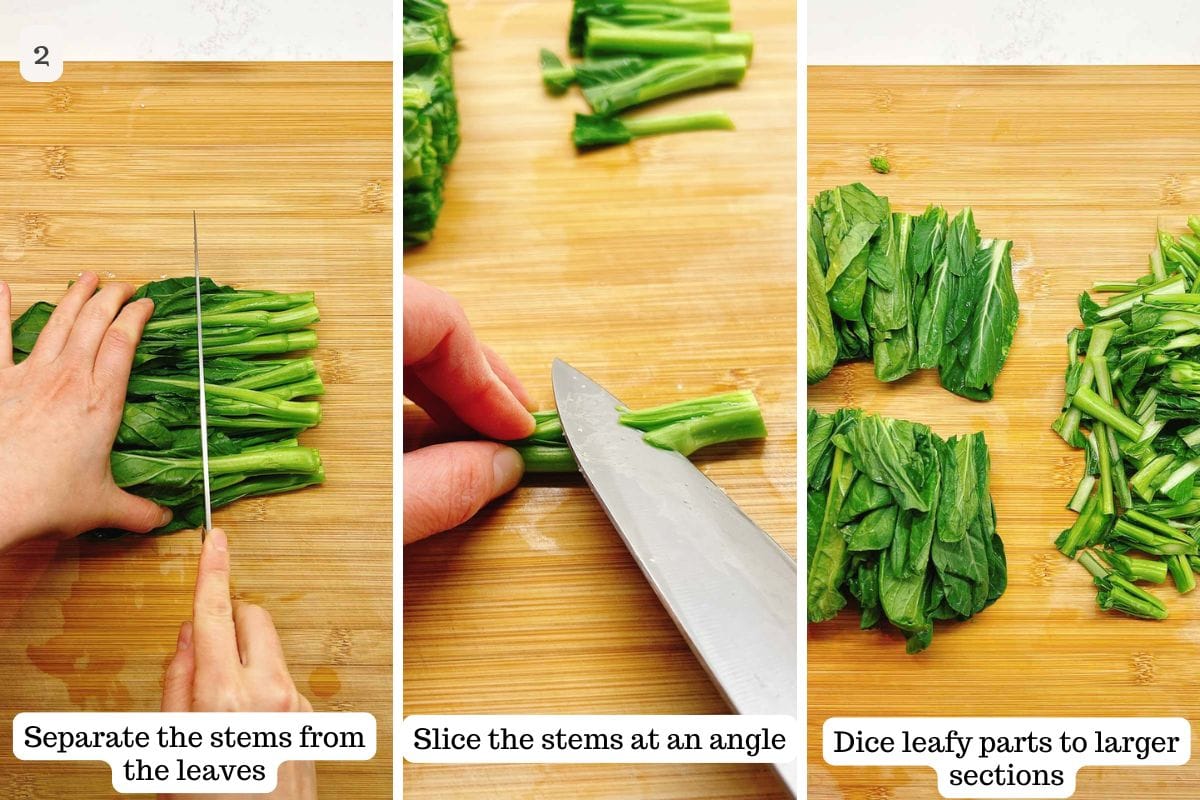
This is the step that prevents soggy leaves and undercooked stems. The thick stalks need more time in the pan, while the leafy tops cook in seconds. Cutting the stems at an angle gives more surface area and lets them cook faster, so everything comes out just right—tender leaves, crisp-but-cooked stems.
- Why Heat Control Matters
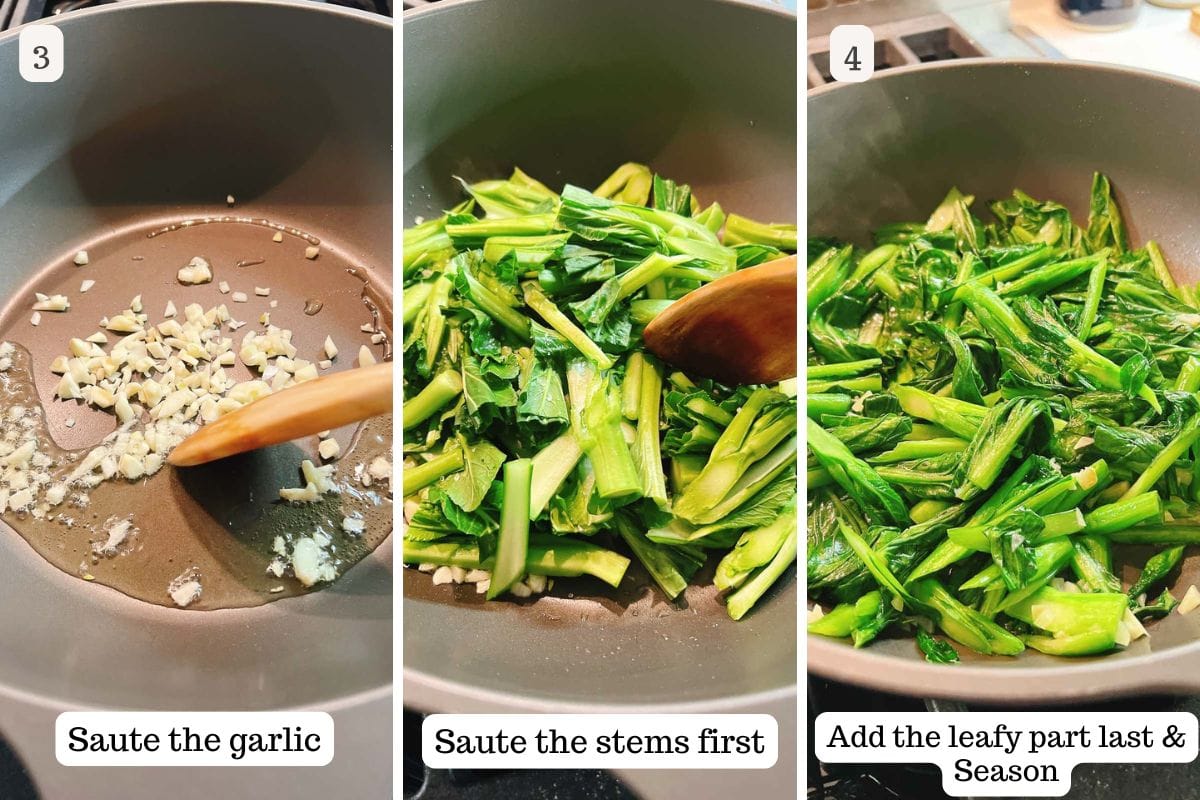
You want a hot pan, but not too hot. Medium heat helps you bloom the garlic without burning it. Garlic burns fast—especially if the oil is too hot or if you’re distracted for even a few seconds. That quick 5–10 second stir gets the flavor going without turning bitter.
Once the garlic is fragrant, the heat gets bumped up later to help dry out moisture and give the greens a little wok-like char without overcooking.
- Season in Layers
You’ll notice the salt goes in twice—once with the stems, then again with the leaves. This helps layer the flavor without dumping it all at the end. Choy sum has a light, slightly bitter taste, so seasoning in stages + a quick splash of wine helps balance that out.
- Deglaze to Add Flavor
Deglazing with Chinese cooking wine lifts any browned garlic bits off the pan and blends them into the dish. This tiny splash at the end also gives the greens a light, savory finish and helps mellow out any bitterness. Just make sure the pan isn’t too wet—if there’s a lot of moisture, your greens will steam instead of stir fry.
- Listen for the Sizzle
You should hear a gentle sizzle the whole time you’re cooking. That’s a good sign your pan is hot enough to keep the greens crisp and fresh without steaming them.
Seasoning variations
Want a stronger flavor? You can absolutely use oyster sauce, soy sauce, or both. In my experience, oyster sauce gives the biggest flavor boost with the least effort. To use it, just mix 1 tablespoon of oyster sauce with the cooking wine, then pour it into the pan when you deglaze. It adds a savory, slightly sweet glaze that pairs really well with the greens.
What to serve it with
This Garlic sautéed choy sum goes with just about anything—from quick proteins to cozy rice dishes. Here are my family’s favorite go-to pairings:
- Vegetarian: Try it with braised tofu, honey garlic tofu, or scallion oil noodles —both are bold, saucy, and balance the fresh crunch of the greens perfectly.
- Chinese: Serve alongside Chinese eggplant with garlic sauce or Chinese sausage fried rice. The richness from the eggplant or the sweet-savory sausage plays so well with crisp, garlicky greens.
- Taiwanese: Pair it with sha cha beef or lu rou fan. The deep, savory flavors in both dishes make this light veggie stir-fry the perfect contrast.
FAQs
Yes—always. The stems take longer to cook than the leaves, so they go in first. If you’re using smaller yu choy (about 6.5–7 inches / 16.5–18 cm), you can leave the leafy tops whole. For larger stalks, slice the stems into smaller rounds and cut the leaves into a few bigger sections. This helps everything cook evenly without overcooking the tender parts.
Cook the leaves briefly over medium-high heat—just 1 minute is enough. You’ll see the color change from pale to a vibrant green. Stop there to keep the greens fresh and bright.
Start with super fresh choy sum and don’t overcook it. A quick splash of Chinese cooking wine at the end also helps round out the flavor and soften any bitterness. It adds depth without overpowering the greens.
Try these Chinese stir fry greens next!
If you love to learn more about Chinese greens, here are more quick and flavorful veggie sides to add to your dinner rotation:
- Chinese Broccoli Stir Fry – Crisp-tender stems and garlicky leaves in a savory sauce.
- Bok Choy Stir Fry – Light, juicy bok choy with garlic and a splash of seasoning.
- Chinese Mustard Greens – Bold and peppery, sautéed with garlic and ginger.
- Sautéed Snow Pea Leaves – Delicate and earthy greens with a simple garlic stir-fry.

Stir fried choy sum recipe
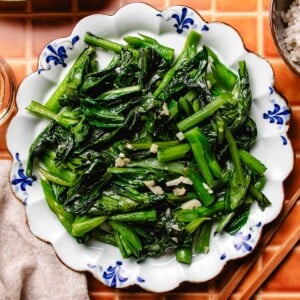
Ingredients
- 1 lb. Yu choy about 6.5-7 inch in length
- 0.5 oz garlic minced, 2 large
- 1.5 tbsp avocado oil divided
- ¼ tsp coarse sea salt or more to taste
- 1 tbsp Chinese cooking wine or gluten-free sake
Instructions
- Trim and Clean the Yu Choy: To prepare the yu choy, trim a small amount off the bottom ends to remove any dry tips—about ¼ inch. Plunge them into a bowl of cold water a few times, gently separating the layers to rinse away hidden dirt. Set aside to drain and pat dry.
- Slice the yu choy: Cut to separate the stems from the leafy parts. Slice the stems at a 45-degree angle so they cook faster. Leave the leafy parts whole.
- Preheat the Pan and Sauté Garlic: Preheat a large sauté pan over medium heat with 1 tablespoon of oil until it feels hot but not smoking. Add the garlic and stir quickly with a wooden spoon for 5 to 10 seconds. Be careful not to let it burn.
- Cook the Stems First: Add the yu choy stems and season with ⅛ teaspoon salt. Sauté for 1 minute.
- Add the Leaves and More Oil: Add the leafy parts, the remaining ½ tablespoon of oil, and another ⅛ teaspoon salt. Turn the heat up to medium-high and sauté for 1 minute more.
- Deglaze and Finish Cooking: Deglaze with the wine and cook for another 30 seconds, or until the leaves turn from pale to dark green and the stems are still crisp. There should be very little moisture left in the pan. Turn off the heat.
- Taste and Serve: Taste and adjust with more salt if needed. Transfer to a serving plate and serve hot or warm.
Notes
- You should hear a gentle sizzle during the stir fry—that means your pan is hot enough.
- Keep an eye on the timing and heat. There should be very little moisture left in the pan when it’s done cooking. That’s how you get crisp, vibrant greens without turning them soggy.
Nutrition
Nutrition information is automatically calculated, so should only be used as an approximation.




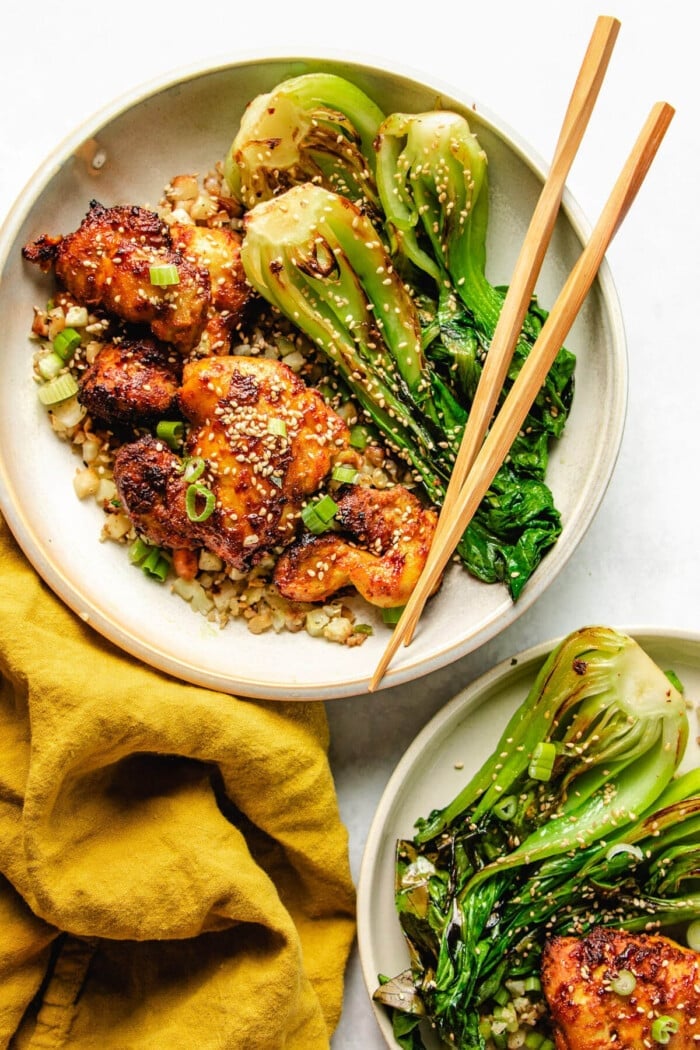








My local Asian market had beautiful yu choy today, and this was the perfect recipe for it. Easy and delicious!
That’s perfect! So happy to hear! We absolutely love yu choy – healthy and delicious! 🙂